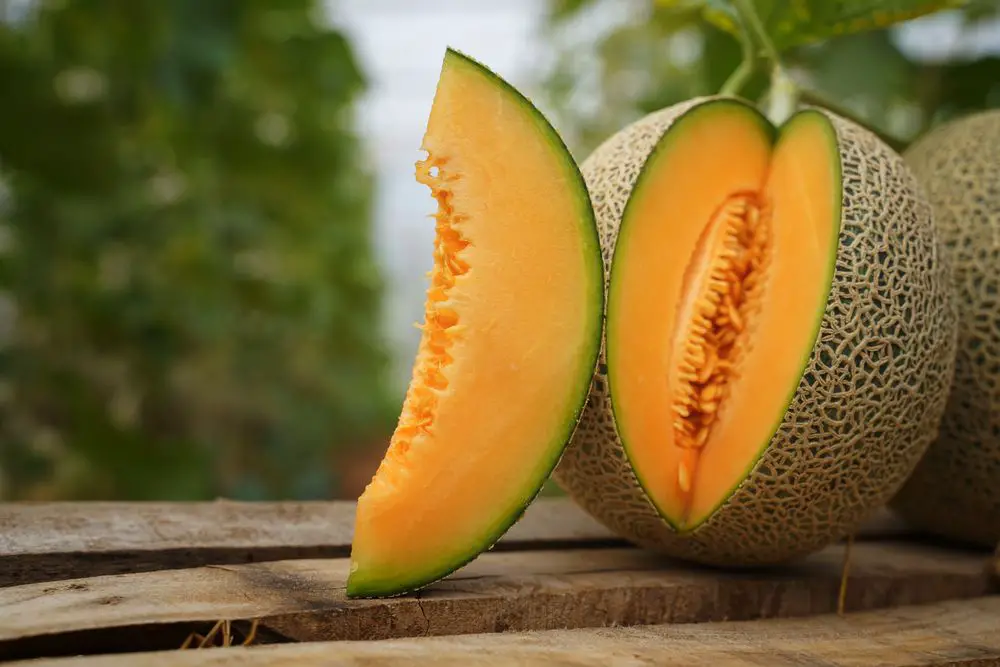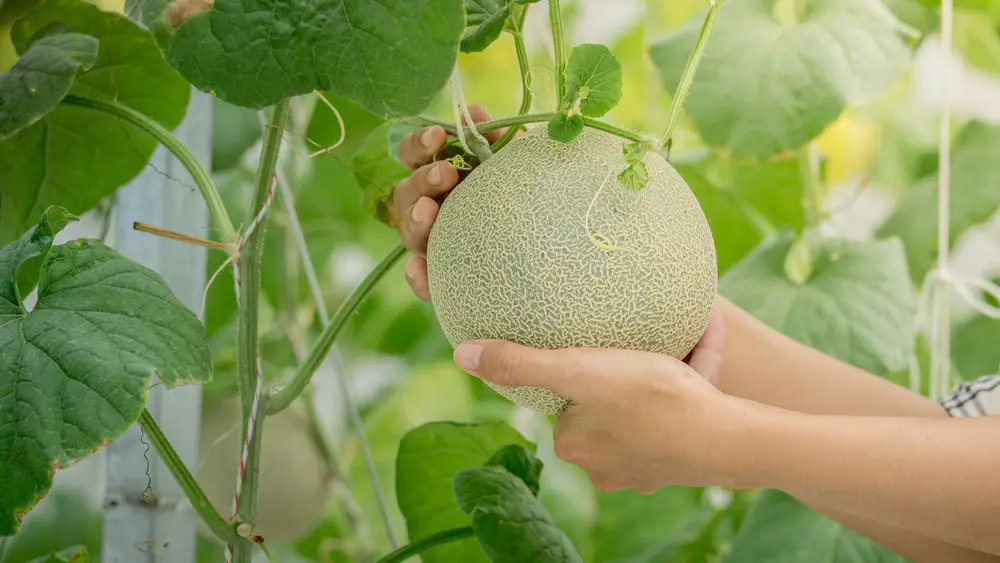What is more refreshing than biting into a sweet, juicy melon? Kowing which one you prefer could be challenging because there is a considerable variety of melons, and you would need to understand the differences between all the types.
To grow a cantaloupe melon, you need a good location, plant at the right time, consider potted planting, general growing care, pruning, and harvesting.
How To Grow Cantaloupe
The soil, weather, and long growing season are perfect for Cantaloupe plants. With all the essential requirements met, your Cantaloupe plants have vigorous vines, the fruits are huge, and the flavor is unmatched!
Having the right conditions and enough space, Cantaloupe is a breeze to grow. They love hot weather and tend to spread. So, you’ll want to make sure to have enough growing space. Otherwise, you can train them up a fence or trellis to grow them vertically.
6 Perfect Tips for Growing Cantaloupe:
1. Choose The Best Location.
This kind of fruit prefers full sun. Place the Cantaloupe in a sunny location for a good start and needs limited watering once settled in their location. Plan accordingly the best location wherein they will have room to grow and thrive at its fullest.
Also, use well-draining soil that is rich in organic matter. It is necessary to amend the soil with compost and a balanced organic fertilizer.
2. Plant The Cantaloupe Seeds At The Right Time.
Start planting your Cantaloupe seeds into the trays or directly into the soil. Cantaloupes are best propagated by seed, with the seed having viability up to ten years.
They do best when directly sown and sow seeds outside or directly to your garden about two weeks after the last frost date when the soil temperatures are about 65℉.
Cantaloupes prefer warm weather, so don’t plant them before temperatures have warmed in the spring.
The Cantaloupe seeds need light to germinate. Observe space distancing and space your rows between plants 6″ to 9″ apart to maximize air circulation and reduce powdery mildew—plant Cantaloupe seeds at ½” depth.
Prepare compost and manure added or a balanced organic fertilizer to the soil before planting.
Mulching, whether you use black plastic mulch or clear plastic mulch and straws, is also highly recommended for your Cantaloupes.
This method of Mulching helps reduce the fruit contact with the soil, which can lead to disease and rotting of your Cantaloupes.
Old-time gardeners have said that lowering melon contact with the earth was necessary to keep your cantaloupe crop at its best.
3. Potted Planting of Cantaloupe.
Perhaps you’re short on space and considering the idea of container gardening. Cantaloupes can be grown in large pots. However, be sure you have some trellis.
The Cantaloupe plant will still want to trail along the ground. You can use a cage, lattice fencing, or any other sort of trellis-like structure.
Once the plant becomes a vine, carefully pull the vine and tendril up and tie them onto your frame. Keep maintaining on top of this as the plant grows throughout the season.
As soon as the fruit begins to swell, you need to support the Cantaloupes as they start to get bigger. You can use any netting as a sling, or you can also buy special melon nets online.
What is the advantage of growing Cantaloupes “in pots VS. in the ground?” This fruity plant, the Cantaloupe that grows in pots will have less contact with the soil lessening the diseases and pests.
4. Care For Cantaloupe Throughout Its Growing Season.
Mulching the Cantaloupe plants to help retain moisture from seeds to seedlings, regulate its temperature, control weeds, and keep fruit clean.
- It is highly recommended by experts to water early in the morning or late in the afternoon. Avoid the leaves getting wet, which can encourage diseases.
- This fruit plant prefers light, well-draining soil with a pH of 7.0. Rich sandy loam soil is best for these melons. Sun exposure is also ideal for soaking up the maximum amount of light.
- Be alert and look out for bees. Cantaloupe male flowers will appear first and followed by female flowers. Once the female flowers wither and die, consider future blooms.
- To fertilize the Cantaloupe plant when vines start growing.
- Don’t overwater your Cantaloupes while fruits are growing. Too much water (or rain) could produce bland-tasting fruit.
- Give your Cantaloupe vines and fruit an extra magnesium boost with an Epsom salt foliar spray. Spray the plant when leaves begin to vine and when fruits are growing.
- Give them a well-balanced variety of nutrients, with higher levels of potassium. When the plants start to the vine, high nitrogen fertilizer is also beneficial.
5. Pruning Your Cantaloupe.
Through this method, your Cantaloupe vines will increase their productivity. You may fear doing it at first that will hurt your plant. But, it could be better than leaving the plants alone.
Once the vine reaches about 2 ½ feet long, you may remove the end buds of the vine by snipping or pinching it off with your fingers.
Pruning encourages the lateral buds to form, which the vine starts to branch. The Cantaloupe plant will then start to focus on the branches. This could be less taxing on the plant because the growth is not rampant.
Thus, as possible, allow only one or two fruits to form on each vine. In order for the plant to focus its energy on producing better quality melons rather than several tasteless small melons.
6. Harvest The Cantaloupe At The Right Time.
Always be sure to harvest your Cantaloupes at the right stage! They should be in their full slip stage which means that the fruit comes freely off the vine and only needs a light tug.
Take note when it is ready to harvest by gently twisting the fruit from the stem. It should slip away easily. If not, you stop and let it ripen for a few days.
Cantaloupes would continue to soften once picked, but it won’t get any sweeter. Just leaving it on the vine as long as possible will give you the sweetest flavor.
The Cantaloupe rind will change from green to tan or yellow in between the netting on the surface when it is ripe.
They could also be harvested at the half-slip stage, when the stem may not come freely off, but the stem attachment area is smooth, round, and slightly depressed.
When harvesting cantaloupes before the half-slip stage, the fruits will be too green and not ripen properly.
Your Cantaloupes must be firm, well-netted, and well-formed. It must have a sweet, musky smell to it when harvested. It ripens 35 to 45 days after pollination but depending on the weather. They don’t ripen once removed from the vine.
What Is A Cantaloupe?

This humble melon is one of the healthiest and most versatile fruits. Cantaloupe is a juicy and orange summer fruit related to the watermelon and honeydew melon—the same family plant of cucumbers, pumpkins, squashes, and gourds.
The Cantaloupe is also known as rockmelon in Australia and New Zealand. In South Africa, it is called Sweet Melon or Spanspek.
A kind of melon is a variety of the Muskmelon species from the family Cucurbitaceae. The weight of a Cantaloupe ranges from 0.5 to 5 kilograms.
From old times, Cantaloupe referred only to the non-netted, orange-fleshed melons of Europe. But now, it may refer to any orange-fleshed melon.
Are you planning to plant this stunning fruit? To grow a Cantaloupe for yourself in your own garden makes a difference because you will discover that the taste is better than those you find in the supermarkets.
It makes a great addition to your fresh salads and smoothies.
Final Thoughts on How to Grow Cantaloupe
Growing Cantaloupe is a rewarding experience, and it’s usually more rewarding to grow your own food in your own backyard. We hope these tips will prove of great help to you.
Have fun and happy gardening!
Jenny Marie
Tribal Writer
Edited By
Patricia Godwin

